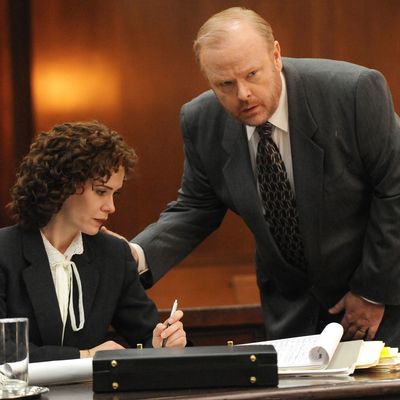
Approaching the first episode of a series as mammoth as The People v. O.J. Simpson is a daunting prospect, like opening a roomful of Pandora’s boxes. Quite apart from the details of the actual case, which had plenty of its own twists and turns, the entire affair was a cultural flash point on race, class, police misconduct, celebrity justice, and the insatiable maw of 24/7 cable news. And that’s just for starters. Let’s dive in with four moments from tonight’s premiere that neatly encapsulate the show’s wide-ranging, near-miraculous appeal.
1. “This is a crime scene.”
Three detectives poke around O.J. Simpson’s estate, following up on the murders of his ex-wife, Nicole Brown Simpson, and her friend, Ron Goldman, at Brown’s home in Brentwood. Simpson isn’t there, but following a tip from a seriously baked Kato Kaelin (Billy Magnussen), the famed freeloader who was living in Simpson’s guest house, they discover one of the two incriminating gloves that connect the pigskin legend to the scene. “This is a crime scene,” one detective says. And on that dramatic cue, up comes the first title: “FX PRESENTS.”
In the rush of those few seconds, The People v. O.J. Simpson establishes a couple of fundamental aspects that wouldn’t necessarily be a given on a TV series about the Simpson case. One is a reminder that two people were brutally murdered on June 12, 1994. The quest for justice for those murders is important to remember, yet the easiest thing to forget about this entire ordeal. The more the Simpson trial grew into a real-time fiasco on national television, the further we felt from the actual crime. That isn’t the natural order of things in a murder trial, but it wound up being a critical aspect of Simpson’s smoke-and-mirrors defense. The line “This is a crime scene,” coupled with the persistent anguish and fury of Marcia Clark (Sarah Paulson) later in the episode, is a bracing reminder that this was a murder like any other — even though it metastasized into anything but.
It’s also a thrilling piece of filmmaking. Director Ryan Murphy, working from a script by co-creators Scott Alexander and Larry Karaszewski (the writing team responsible for Ed Wood and The People vs. Larry Flynt, among other less esteemed films), brings some of the cinematic bravado of his American Horror Story into this episode, which treats the crime scene with a surprising noir slickness. This is no mere docudrama — it has real visual panache.
2. “I don’t want to be late. We have tickets to the premiere of I Love Trouble.”
So says the wife of Robert Shapiro (John Travolta), the soon-to-be celebrity-defense point man who’s holding court with a story about Marlon Brando when he gets a call from O.J. (Cuba Gooding Jr.). The first episode already has plenty of delightful nods to the pop culture of the day, but a reference to the Nick Nolte/Julia Roberts flop I Love Trouble underlines just how comically ephemeral it can be. Things that must have seemed important at the time, like attending the premiere of a new rom-com featuring Roberts — then the biggest female star in Hollywood — now look so small in the rearview mirror. Here Shapiro is, seconds away from becoming a major player in what would become one of the decade’s most significant cultural events, and Alexander and Karaszewski send I Love Trouble, a ragged hunk of Hollywood flotsam, on its inexorable drift toward the shore. Comic ironies like that can be cheap — e.g. “Something Picasso? He won’t amount to a thing!” in Titanic — but the contrast between a Julia Roberts bomb and the O.J. Simpson trial is a meaningful (and funny) comment on how pop-culture items shift during flight.
3. O.J. Simpson tried to kill himself in Kim Kardashian’s room!
I’ve deliberately not watched past the first episode, but I’ve heard gripes from some critics (who have access to the first six) that the Kardashian angle is overplayed on the show. Certainly, Robert Kardashian (David Schwimmer), O.J.’s friend and a volunteer assistant on his legal team, is an important figure in this story, especially in the first few chaotic days depicted in this hour. His daughters were of zero importance in the narrative then, but today their reality empire could almost be described as a spinoff, The Ropers to the O.J. trial’s Three’s Company. So with the caveat that repeated Kardashian sisters references could yield diminishing returns …
Holy shit, O.J. had to be talked out of shooting himself in Kimmie’s bedroom! The same Joey Lawrence–and–Jonathan Taylor Thomas–poster-festooned bedroom where he and his girlfriend Paula Barbieri (Angie Patterson) bunked the night before!
Alexander and Karaszewski may be overplaying their hand here, but they’re only human. And so are we. This is an irresistible collision of past and present.
4. The white Ford Bronco takes to the freeway.
The single most galvanizing moment of the whole surreal affair: a fugitive and suicidal O.J. Simpson heading down the California freeway in his white Ford Bronco, driven by his former teammate Al Cowlings (Malcolm-Jamal Warner). Most of America — probably all of America — experienced this slow-speed chase as it was broadcast live, with the Bronco trailed by a phalanx of police cars and gawkers waiting at every overpass. But The People v. O.J. Simpson shows us what we couldn’t see: those early moments when Simpson and Cowlings gave authorities the slip and careened down the freeway to points unknown. Murphy shoots it elegantly, in a single shot that starts from the vantage of a passed car and cranes up as the Bronco weaves through traffic like a particularly anxious commuter. We remember the Bronco from one angle — the overhead helicopter shot, with cops in pursuit — and Murphy has cleverly recontextualized it by showing us another time and another angle we weren’t privy to witness. This is what art can do to history: imagine scenes we could not see, or approach events from a fresh perspective.
And therein lies the promise of The People v. O.J. Simpson.
Dancing Itos:
- Many movies and TV shows have used footage of the Rodney King beating as shorthand for racial tension and mistrust — Spike Lee tucked it into Malcolm X in 1992, only a year later — but there’s just no more efficient way to put the Simpson trial in perspective.
- The performances are all over the map — and some, like Travolta as Shapiro, are off the map entirely — but Paulson’s Marcia Clark gives the ensemble a powerful center. In this first episode, at least, Alexander and Karaszewski seem intent on making Clark a righteous heroine undone by circumstances out of her control. “Oh my God,” she says when the Juice goes loose. “We’re going to look like morons.” Indeed, they are. But should she?
- One more funny Kardashian joke: Robert muscles his way up to O.J.’s estate, only to get stopped by the police. “O.J. is expecting me,” he says. “I’m sure I’m on the list.” Kardashians are accustomed to getting waved into the club.
- Courtney B. Vance plays Johnnie Cochran with the requisite Hollywood charisma and savvy. He has Shapiro pegged (“He’s a plea-bargain guy, not a litigator”) and sees the Simpson case as a loser. He may be wrong on the latter, but he’s not really wrong on the latter.
- Schwimmer carries a mini-dramatic arc as Kardashian, the loyalist who doesn’t believe for a second that O.J. did it until his friend’s behavior challenges his resolve. The catastrophic lie-detector test is a gut-punch that Schwimmer absorbs quite touchingly as he faces both a bad result and O.J.’s ensuing tantrum. After the Bronco peels off, he’s crestfallen.
- Can we get a full webisode of Kato Kaelin attempting to invoke his Fifth Amendment right to remain silent? Or maybe just a GIF of Clark’s incredulous reaction?


